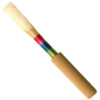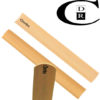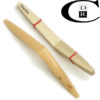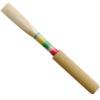Often, the confusing array of letters and number Heckel uses on their bocals seem inscrutable.
We’ve compiled information from numerous Heckel charts detailing the original specifications of Heckel bocals and translated it to English.
The numbers and letters are stamped on the bocal either near the makers name on the central area, and/or at the butt, just above the cork on the inner side. Sometimes, a too long cork will obscure the mark. The “R” variation is marked only on the ring below the cork.
How to identify a Pre-War Heckel bocal
To determine if your bocal was made prior to 1945 or “Pre-War”, look at the maker’s mark stamped on the metal. If it is imprinted with a slightly spiral twist, it is not Pre-War. If it appears to be straight in a line and runs along the bocal without twisting, it is most likely a Pre-War bocal. You are welcome to send us photos for a second opinion.
The Heckel factory was partially destroyed during WWII. The forms they used to produce bocals were destroyed. The bocals produced before 1945 using those original forms are prized for their rarity. The ones produced after have maintained the high quality for which Heckel is known.
Heckel Bocal Markings
- Lengths:
Use these numbers as a relative guide. Your bassoon, reed, and embouchure determine your pitch as much as the bocal.
#00 = Shortest length with pitch centered at A=446 Hz
#0 = Somewhat shorter length with pitch centered at A=444 Hz
#1 = Average length with pitch centered at A=442 Hz
#2 = Average length with pitch centered at A=440 Hz
#3 = Somewhat longer length with pitch centered at A=438 Hz
#4 = Longest length with pitch centered at A=436 Hz
- Plating Options:
N = German silver (standard warm tone)
Z = German hard silver (brighter tone)
G = Goldbrass (mellow, quieter)
AG = Sterling silver (brighter but quieter)
AU = Gold 8 Karat (mellow direct sound)
14K = Gold 14 karat (markedly mellower sound)
18K = Gold 18 karat (even mellower)
PD = Palladium (for nickel or silver allergy – intense tone)
- Letter Meanings
B = Soft silver alloy. Thick wall. Narrower bore than the CC. Best for high register.
E = Soft Silver alloy. Narrower tip opening. More focused tone.
C = Hard silver alloy – rich, brilliant tone. Same bore size as the CC.
CC = Soft silver alloy. Standard bore size. Warm, blended tone.
D = Hard silver alloy. Thinner wall thickness. Increased response and vibration.
V = C bore with a slightly different taper preferred for older instruments. Very even intonation.
XL = Variant available in all bocals. Offers improved response in the high register. Matches well with Fox bassoons.
R = Variant available in all bocals. Compressed metal for a wider sound spectrum, more responsiveness. The label is directly underneath the cork and there is no stamp on the body of the bocal.
- Multiple letter meanings
CD = Hard silver alloy, thin walled. Excellent intonation and responsiveness.
CE = Hard silver alloy. Narrower tip opening, increased response in the upper register
CCE = Soft silver alloy. Narrower tip opening, increased response in the upper register
CDE = Hard silver alloy. Thin wall, narrower tip opening, increased focus and response in the upper register
VC = Hard silver alloy. Special taper preferred for older instruments. Very even intonation.
VCC = Soft silver alloy. Special taper preferred for older instruments. Very even intonation.
VCD = Hard silver alloy. Thin walled and special taper preferred for older instruments. Very even intonation.
VCE = Hard silver alloy. Special taper, narrower tip opening.
VCCE = Soft silver alloy. Special taper, narrower tip opening.
VCDE = Soft silver alloy. Thin wall, special taper, narrower tip opening.
BD = Soft silver alloy. Thin wall, narrower bore.
BB = Hard silver alloy. Thick wall, narrower bore.
BBD = Hard silver alloy. Thin wall, narrower bore.







